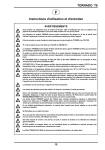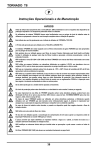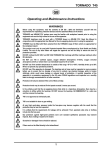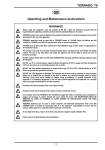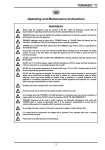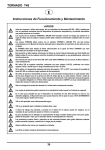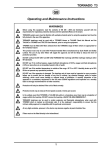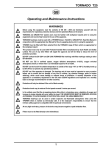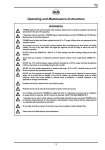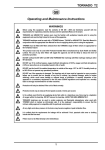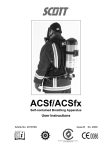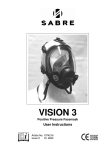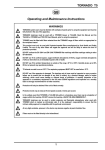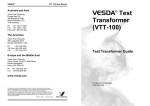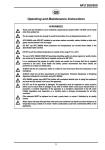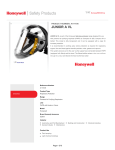Download 5 - Scott Safety
Transcript
TORNADO T8 Operating and Maintenance Instructions WARNINGS Before using this equipment, read the contents of EN 529 : 2005 and familiarise yourself with the requirements for respiratory protective devices and their potential effects on the wearer. TORNADO system users must be familiar with workplace hazards prior to using the equipment and must be fully trained in the use of the apparatus. This Manual must be read in conjunction with the User Manual for T/POWER and T/FILTER. T8 is not approved for use with T/A/LINE or AIRLINE FCV. T/POWER must be fitted with filters selected from the TORNADO range of filters which are appropriate for the workplace hazard. This product must only be used with Protector-branded filters manufactured by Scott Health and Safety Limited. The use of any other filters will negate the approval and will be likely to reduce the level of protection provided. DO NOT confuse the EN 12941 and EN 12942 TORNADO filter markings with filter markings relating to other EN standards. DO NOT use T8 in confined spaces, oxygen deficient atmospheres (<19.5%), oxygen enriched atmospheres (>23%) or where there is an immediate hazard to life or health. DO NOT use if the ambient temperature is outside of the range -10°C to +50°C. Humidity levels up to 95% RH do not present any operational problems. DO NOT use if the apparatus is damaged. The facemask and air hose must be inspected on every occasion before use to ensure that no damage of any kind is evident, (eg chemical damage, splits or broken stitching), which could cause leakage or reduced levels of protection. A monthly inspection of the apparatus is a mandatory requirement in the UK under COSHH regulations and inspection on a monthly basis is strongly recommended for all other countries. Protection will only be obtained if the unit is fitted correctly. Protection levels may be reduced if wind speed exceeds 2 metres per second. In the unlikely event of T/POWER failing while in a hazardous atmosphere, there may be a reduction in airflow within the face-piece. DO NOT REMOVE THE FACE-PIECE. GO IMMEDIATELY to a safe area and then remove the facepiece. TORNADO face-pieces can be used in certain explosive and flammable atmospheres when used with T/POWER which is marked as intrinsically safe. It is the employer’s responsibility to ensure that the intrinsic safety approval is compatible with the particular environment. At very high work-rates, pressure in the device may become negative at peak inhalation flow. DO NOT use with a low airflow output. T8 must not be used where contaminant concentration exceeds 20 times its Occupational Exposure Limit, or 1000 ppm by volume. It is unlikely that the requirements for leakage will be achieved if hair, spectacle side arms or clothing intrude into the face-seal. DO NOT modify facemasks as this will invalidate all approvals and may result in death or injury to the wearer. TORNADO filters (EN 12942) must not be fitted directly to the face-piece. 1 TORNADO T8 SPECIFICATION Description: Classification: Minimum Design Flow Rate: Assigned* (Nominal) Protection Factor: Operating Temperature Limits: Material: Inner Mask Outer Shell Weight: Half-mask with hose connection to EN 148-1 EN 12942 TM2 110 L/min 20 (200) -10°C to +50°C Silicone Elastomer Acrylonitrile Butadiene Styrene (ABS) 180 Grams * According to EN 529 : 2005 If T8 is to be used with a single filter mounted directly to the mask, filters from the Pro2000 Range should be selected. MARKINGS AND MEANINGS The T8 half-mask markings are in conformance with EN 12942, as follows: The following Pro2000 available for use with T8: Outer Shell Markings: Marking SCOTT EN12942 TM2 T8 Meaning Part No. Name of manufacturer Standard - powered respirator Class designation Product name EC251R EC220R EC221R EC223R 5042674 EC230R EC238R EC200R EC201R EC203R 5042874 EC219R Inner Mask Markings: Marking Meaning SHS CE 0086 S/M M/L EN140 : 1998 Manufacturer’s identification mark CE mark Certifying body Size - Small/Medium Size - Medium/Large Standard - negative-pressure half-mask Date of manufacture: 07 Indicates year (2007) Filter Type P3 A2 P3 B2 P3 K2 P3 A2 B2 P3 A2 B2 E1 P3 AE1Hg P3 A2 B2 K2 A2 B2 AX filters are Standard EN 143 : 2000 EN 14387 : 2004 EN 14387 : 2004 EN 14387 : 2004 EN 14387 : 2004 EN 14387 : 2004 EN 14387 : 2004 EN 14387 : 2004 EN 14387 : 2004 EN 14387 : 2004 EN 14387 : 2004 EN 14387 : 2004 Note: All of the above filters are sold in packs of 20. WEARING Indicates month (June) WARNING: The half-mask should be examined for damage of any kind such as deep scratches, abrasions, cracks and deterioration before every use. Damaged parts, components which have come into contact with solvents and parts that have received significant impact should be replaced. FILTER SELECTION T8 can be used either with a T/POWER respirator in conformance with EN 12942, or with a single filter mounted directly to the mask in conformance with EN 140. Each of the applications described above use a different type of filter and IT IS ESSENTIAL that the correct filter type is selected for the chosen application. CAUTION: Whilst the materials which may come into contact with the wearer's skin are not known to be likely to cause skin irritation or other adverse effects to health, they may cause allergic reactions in particularly susceptible individuals. When T8 is to be used in conjunction with T/POWER, filters from the TF Range should be selected. Full details of the range of filters available can be found in the T/POWER User Manual. 2 TORNADO T8 Note: Initial donning procedures should be supervised by a competent person. 1. Select the appropriate size of mask: S/M or M/L. 2. Check that all parts of T8 are clean and in good condition. 3. If using T8 with T/POWER, connect the breathing hose to the mask. Tighten the nut, ensuring that the elbow is at a suitable angle. DO NOT over-tighten. If fitting a filter directly to the mask, screw the filter in a clockwise direction, fully into the side fitting, until finger-tight. DO NOT over-tighten. Fig. 2 Note: The mask should feel firm against the face with no undue movement. If a correct fit cannot be achieved or the mask is uncomfortable, adjust the harness length using the nape buckle (it may be easier to do this prior to donning the mask). 4. Adjust the harness so that the buckle is away from the mask and the head pad rests on top of the mask. Place the strap around the neck (see Fig. 1). CAUTION: Excessive tightening causes discomfort and may distort the faceseal. Fig. 1 7. Test the face-seal by blocking the breathing hose/filter inlet with the palm of the hand and inhaling. Check that the mask pulls onto the face and remains in position until the breath is exhaled. If a leak is evident, check the face-seal and exhalation valves. Note: Once a comfortable fit has been achieved for a given wearer, there should be no need to alter the head-strap length when donning in the future. Note: If a correct fit still cannot be achieved or if the mask continues to leak, it may be necessary to try the alternative size of mask. 5. Place the half-mask on the face and adjust until the face-seal fits snugly against the face. WARNING: DO NOT use the mask if a correct fit cannot be achieved or if persistent leaks are evident. 6. Pull the head pad onto the crown of the head (Fig. 2) and adjust the harness, feeding the harness through the anchors to equalise the pull of the harness. 8. If using T8 with T/POWER, arrange the breathing hose so that it trails freely down the back and is not kinked, likely to snag or be crushed. 9. Follow the instructions T/POWER User Manual to: 3 in the TORNADO T8 i) ii) iii) Attach the breathing hose to the T/POWER unit; Perform the air-flow test; Check the filters. MAINTENANCE Inner Mask and Outer Shell: Inspect for holes, surface damage or excessive distortion, particularly around the inlet port. Ensure that the inner mask is flexible and shows no signs of damage. The inner mask and outer shell should be discarded after five years in service, regardless of condition. AFTER USE WARNING: DO NOT remove the half-mask until well clear of the hazard area. 1. Remove the half-mask unscrew the breathing hose or filter. and Valve Flaps: Visually inspect valve flaps every three months to ensure that they are clean and undamaged. Valve flaps must be replaced annually regardless of condition. Valve flaps in storage have a shelf-life of five years, after which time they should be discarded. 2. When removing a filter which is fitted directly to the mask, ensure that the filter is not clogged, saturated or timeexpired. Filters found to be in this condition must be renewed. 3. Clean the mask and the outside of the breathing hose with a synthetic sponge moistened in a mild solution of soap and warm water, or TriGeneTM solution. Exhalation valve flaps are marked with a code indicating the year of manufacture. The code ‘07' corresponds to 2007 and a dot is added each year thereafter, so ‘07.' would equate to 2008. CAUTION: DO NOT allow water to enter the breathing hose. Harness Components: Check for any signs of possible failure, paying particular attention to the anchor tags. 4. Rinse the mask thoroughly under clean running water and hang it by the harness until thoroughly dry. RECORD INSPECTION AND MAINTENANCE DETAILS CAUTION: DO NOT use radiant heat or sunlight to speed drying. Record test and maintenance details on the Inspection and Maintenance Record Sheet provided at the back of this Manual. 5. Use TriGeneTM wipes to sanitise the face-seal. 6. After cleaning, check to ensure that all components are in good condition. Information recorded usually includes: • Name of employer responsible for the apparatus. • Make, model number or identification mark of the apparatus, together with a description of any distinguishing features, sufficient to enable clear identification. • Date of the inspection/ maintenance together with the name, signature or unique authentication mark of the examiner. • Condition of the apparatus, details of any defects found and any remedial action taken. WARNING: Worn or damaged components MUST be renewed prior to further use. STORAGE When not in use, the equipment should be stored in a clean, dry environment, away from direct heat sources between +10ºC and +30ºC, at a humidity of less than 65% RH. 4 TORNADO T8 SPARE PARTS Item No. Description Part No. Mask and Shell Sub Assembly - 2 Valve Flap Service Kit 2016808 3 Inhale Valve Flap - 4 Exhale Valve Flap - 5 Overhaul Kit 2016809 6 Inhale Valve Frame and Pin - 7 Exhale Valve Cover - 8 Harness Assembly 2016807 1 9 Breathing Hose - TriGene Liquid (1 Litre) 2008247 TOR7/HOSE/EPDM - TriGene Disinfecting Wipes (Pack of 20) 2004225 5 TORNADO T8 2. Insert the anchor tags on the replacement harness into the slots in the outer shell. Check that each tag clicks into place and is securely attached. Ensure that the harness is not twisted or tangled. FITTING SPARES To Replace the Hose: 1. Remove the hose from the mask by unscrewing in a counter-clockwise direction. 2. Connect the replacement breathing hose to the mask by screwing in a clockwise direction. Tighten the nut, ensuring that the elbow is at a suitable angle. DO NOT over-tighten. WARRANTY The products manufactured at our factories in Skelmersdale and Vaasa carry a warranty of 12 months (unless stated otherwise) for parts, labour and return to site. The warranty period runs from the date of purchase by the end user. To Replace the Exhale Valve Flaps and Valve Covers: 1. Hold the valve cover using the lower cut-out as leverage and pull to remove the cover from its housing. These products are warranted to be free from defects in materials and workmanship at the time of delivery. SCOTT will be under no liability for any defect arising from wilful damage, negligence, abnormal working conditions, failure to follow the original manufacturer’s instructions, misuse or unauthorised alteration or repair. 2. Grasp the exhale valve flap and pull gently to remove from the housing. 3. Check that the replacement flaps are in good condition and carefully pull the stem of each flap through the centre of the valve frame, until the flap lies flat against the frame. Evidence of purchase date will need to be provided for any claims arising during the warranty period. All warranty claims must be directed through SCOTT Customer Services and in accordance with our sales return procedure. 4. Align the valve cover with the slots in the housing and snap the cover into place. To Replace the Inhale Valve Flap: 1. Working from the inside of the mask, push out the valve frame, flap and pin assembly and withdraw from the mask. NOTIFIED BODIES Inspec International Limited (0194) 56 Leslie Hough Way, Salford, Greater Manchester, M6 6AJ, England. 2. Remove the valve flap from the valve pin. 3. Check that the replacement valve flap is in good condition and carefully fit the replacement flap over the valve pin. BSI Product Services (0086) Kitemark House, Maylands Avenue, Hemel Hempstead, HP2 4SQ, England. 4. Re-fit the valve frame, flap and pin assembly into the housing in the mask, taking care to ensure that the valve frame is correctly seated within the housing. Check that the flap lies flat against the frame. To Replace the Harness: 1. Push the harness anchor tags from the outer shell to free the harness assembly. 6






